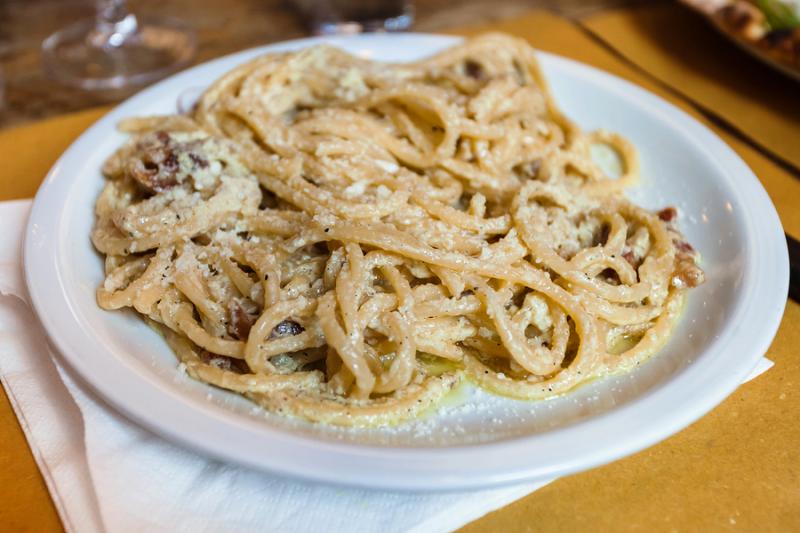On the Origins of Carbonara
ITA:

Use player to listen to Italian version

Paywall Content
Ed., Sep. 1, 2024: As the Kraft Heinz food manufacturing corporation announces the launch of canned carbonara (much to the chagrin of opinionated Italians and their online foodie disciples), we revisit the murky origins of the beloved recipe.
A beloved recipe that is known, emulated and revisited the world over, pasta alla carbonara is associated with Roman cuisine, but its origins are unclear, and while many stories exist, none seem to be definitive.
The origin of a dish can usually be gleaned from recipe books, and it looks like there are no written recipes of carbonara before the 1940s. There are, however, some possible predecessors: for example, the first combination of egg and pasta seems to date from 1773, mentioned by Neapolitan chef Vincenzo Corrado in Il cuoco galante. In the 18th century, pasta dressed with cheese was widespread in most of Italy, and in 1881, another Neapolitan cook described maccheroni tossed with cheese and eggs.
It was not until much later that the use of lard or guanciale as a condiment for pasta was recorded in cookbooks.
What is often cited as the first carbonara recipe, similar but not identical to the one we know today, first appeared in August 1954, when it was published by food magazine La cucina italiana. The ingredients were spaghetti, egg, pancetta, gruyere and garlic.
The following year, carbonara appeared in a cookbook in a version more similar to today’s, this time with eggs, pepper, parmigiano (or pecorino, for a spicier taste) and pancetta.
Guanciale replaced pancetta for the first time in 1960, when panna (cream) was also featured in the recipe, something that today would be considered a misstep.
Indeed, up until the 1990s, there were other ingredients in the recipe for carbonara, such as wine, garlic, onion, parsley, bell pepper, black pepper and chili pepper, that are absent from today’s recipe, which only features egg yolk, pecorino cheese, guanciale and black pepper.
As for how the dish was invented, one of the most widespread theories concerns American soldiers in Rome during and right after World War II, when food shortages were extreme. As a result, there was a marrying of traditions: the egg and bacon dish typical of American breakfast with pasta with cacio (cheese), which had already been common in Italy for centuries.
Carbonara does not appear to have any ancient ancestors. According to food magazine Gambero Rosso, the story of charcoal burners who, when out for work in the central Apennines, filled their baskets with dry spaghetti, eggs, pancetta and pecorino is historically unfounded, although some consider carbonara an evolution of this tradition.
Ricetta amata, conosciuta, imitata e rivisitata in tutto il mondo, la pasta alla carbonara è associata alla cucina romana, ma le sue origini sono incerte e, sebbene esistano molte leggende, nessuna sembra essere conclusiva.
L'origine di un piatto si estrapola dai libri di ricette e pare che non vi siano ricette scritte sulla carbonara fino agli anni '40 del ‘900. Vi sono tuttavia antecedenti: ad esempio, la prima combinazione di uova e pasta sembra risalire al 1773, menzionata dal c











